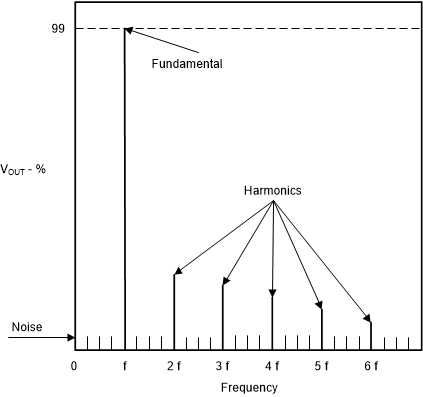SLOA011B January 2018 – July 2021 LF347 , LF353 , LM348 , MC1458 , TL022 , TL061 , TL062 , TL071 , TL072 , UA741
- 1Introduction
- 2Non-Inverting Amplifier
- 3Inverting Amplifier
- 4Simplified Op Amp Circuit Diagram
-
5Op Amp Specifications
- 5.1 Absolute Maximum Ratings and Recommended Operating Condition
- 5.2 Input Offset Voltage
- 5.3 Input Current
- 5.4 Input Common Mode Voltage Range
- 5.5 Differential Input Voltage Range
- 5.6 Maximum Output Voltage Swing
- 5.7 Large Signal Differential Voltage Amplification
- 5.8 Input Parasitic Elements
- 5.9 Output Impedance
- 5.10 Common-Mode Rejection Ratio
- 5.11 Supply Voltage Rejection Ratio
- 5.12 Supply Current
- 5.13 Slew Rate at Unity Gain
- 5.14 Equivalent Input Noise
- 5.15 Total Harmonic Distortion Plus Noise
- 5.16 Unity-Gain Bandwidth and Phase Margin
- 5.17 Settling Time
- 6References
- 7Glossary
- 8Revision History
5.15 Total Harmonic Distortion Plus Noise
Total harmonic distortion plus noise, THD + N, compares the frequency content of the output signal to the frequency content of the input. Ideally, if the input signal is a pure sine wave, the output signal is a pure sine wave. Because of non-linearity and noise sources within the op amp, the output is never pure. THD + N is the ratio of all other frequency components to the fundamental and is usually specified as a percentage:

Figure 5-10 shows a hypothetical graph where THD + N = 1%. The fundamental is the same frequency as the input signal and makes up 99% of the output signal. Non-linear behavior of the op amp results in harmonics of the fundamental being produced in the output. The noise in the output is mainly due to the input referenced noise of the op amp. All the harmonics and noise added together make up 1% of the output signal.
Two major reasons for distortion in an op amp are the limit on output voltage swing and slew rate. Typically an op amp must be operated at or below its recommended operating conditions to realize low THD.
 Figure 5-10 Output Spectrum with THD + N = 1%
Figure 5-10 Output Spectrum with THD + N = 1%